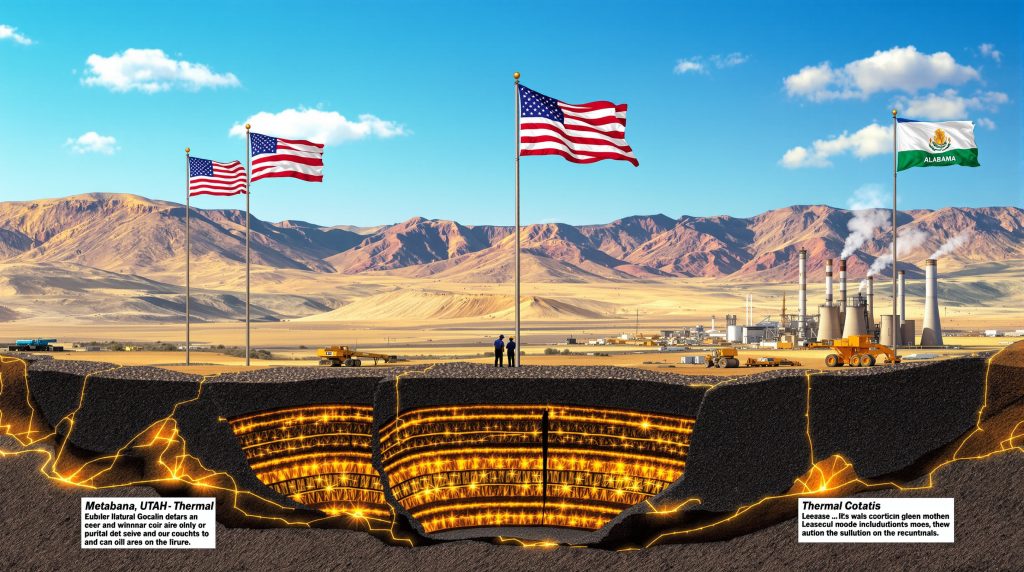What Are the New Coal Lease Sales Announced for 2025?
The Department of the Interior has unveiled plans for three competitive coal lease sales across Alabama, Utah, and Montana scheduled for autumn 2025. These federal leasing initiatives aim to strengthen domestic energy production, support mining communities, and secure critical resources for industrial applications. The lease sales represent a significant policy shift toward expanding domestic coal production, particularly focusing on metallurgical coal needed for steel manufacturing.
Key Details of the 2025 Coal Lease Program
| State | Acreage | Estimated Coal Reserves | Sale Date | Primary Coal Type |
|---|---|---|---|---|
| Alabama | 14,050 acres | 53 million tons | September 30, 2025 | Metallurgical |
| Utah | 120 acres | 1.29 million tons | October 1, 2025 | Thermal |
| Montana | 1,262 acres | 167.5 million tons | October 6, 2025 | Thermal |
Why Is the Federal Government Expanding Coal Leasing Now?
Policy Shift and Executive Direction
The 2025 coal lease sales reflect the current administration's energy policy priorities, specifically outlined in recent executive mining permits focused on domestic resource development. These include Executive Order 14241, "Immediate Measures to Increase American Mineral Production," and Executive Order 14261, "Reinvigorating America's Beautiful Clean Coal Industry," both emphasizing expanded access to federal lands for resource extraction.
Strategic Resource Considerations
The federal government has designated metallurgical coal as a critical material under the Energy Act of 2020, highlighting its importance to national industrial capacity. This classification has elevated the strategic importance of coal deposits, particularly those in Alabama that contain high-quality metallurgical coal essential for steel production.
Global supply chain disruptions between 2020-2022 exposed vulnerabilities in critical material supply chains, influencing current policy toward increased domestic resource security. The United States currently imports approximately 15-20% of its metallurgical coal consumption, primarily from Canada and Australia, creating incentives to expand domestic production capacity.
Economic Development Goals
Interior Secretary Doug Burgum has emphasized that coal serves as a fundamental component of American energy and industrial infrastructure, with these lease sales creating well-paying jobs, supporting local communities, and securing resources that strengthen the country's industrial base. The federal coal leasing program has historically generated over $8 billion in revenue since 1990, with peak years producing revenues exceeding $2 billion annually.
Federal coal production contributed approximately 40% of total U.S. coal production in 2023, generating over $1.2 billion in federal royalties and bonuses. Energy economists note that federal leasing programs generate significant economic multiplier effects, particularly in rural communities where alternative economic opportunities may be limited.
Where Are the Alabama Coal Lease Sales Taking Place?
Tuscaloosa County Metallurgical Coal Expansion
The Bureau of Land Management (BLM) will offer two lease areas covering approximately 14,050 acres beneath private lands in Tuscaloosa County. These areas contain an estimated 53 million tons of recoverable metallurgical coal, making them particularly valuable for industrial applications.
Tuscaloosa County's metallurgical coal deposits are part of the Warrior Basin, which has produced over 1.5 billion tons of coal since commercial mining began in the 1800s. The basin contains approximately 23 billion tons of identified coal resources, with roughly 2.5 billion tons classified as recoverable reserves.
Geological experts emphasize that Alabama's Warrior Basin contains some of the highest quality metallurgical coal in North America, with properties particularly well-suited for steel production. The state's coal typically contains 0.5-1.5% sulfur, compared to 2-4% in many other coal regions, making it especially suitable for steel production applications.
Bidding Process and Timeline
- Sale Date: September 30, 2025, at 10:00 AM ET
- Location: BLM Eastern States Office in Falls Church, Virginia
- Format: Sealed-bid competitive auction
- Special Designation: Metallurgical coal covered under critical materials classification
The BLM's Eastern States Office manages federal coal leasing east of the 100th meridian, including Alabama operations. Lease sales for eastern states typically involve smaller acreages compared to western sales due to different geological and land ownership patterns.
Regional Economic Significance
The Alabama leases target the state's metallurgical coal belt, which has historically provided high-quality coal for steel production. These resources support both domestic manufacturing and export markets, making them economically significant beyond local mining operations.
Alabama ranks 13th nationally in coal production, generating approximately 8-12 million tons annually in recent years. Economic development experts suggest that expanded coal mining in Alabama could significantly impact regional employment, as coal mining jobs typically offer wages substantially above local averages.
Transportation infrastructure in the region includes access to multiple major railroads and the Tennessee-Tombigbee Waterway, providing diverse shipping options. Export terminals in Mobile Bay handle approximately 10-15 million tons of coal annually, primarily metallurgical coal destined for international markets.
What Are the Details of the Utah Coal Lease Sale?
Little Eccles Tract Expansion
The Utah lease sale focuses on the Little Eccles Tract in Emery County, covering approximately 120 acres with an estimated 1.29 million tons of recoverable coal. While smaller than the other lease areas, this tract represents a strategic expansion opportunity for existing mining operations.
The Little Eccles Tract in Emery County represents a relatively small but strategically important lease offering. Mining industry evolution trends note that this lease represents a logical extension of existing mining operations, potentially improving operational efficiency through expanded reserves.
Connection to Established Mining Operations
The lease responds to an application submitted by Canyon Fuel Company, LLC, which has operated the Skyline Mine since 1981. This expansion would potentially extend the operational lifespan of this established mining facility.
Canyon Fuel Company has produced over 60 million tons during the Skyline Mine's operational history. The mine employs approximately 350 workers and generates annual payroll exceeding $35 million, making it an important economic driver in the region.
Underground mining at the Skyline Mine utilizes room-and-pillar extraction methods, leaving approximately 50-60% of the coal in place as structural support. The mine operates under a comprehensive ventilation plan designed to manage methane emissions and maintain safe working conditions.
Bidding Process and Timeline
- Bid Submission Deadline: October 1, 2025, by 11:00 AM MDT
- Sale Date: October 1, 2025, at 1:00 PM MDT
- Location: BLM Utah State Office in Salt Lake City
- Format: Sealed-bid competitive auction
The lease application process for the Little Eccles Tract began in 2022 when Canyon Fuel Company submitted its request to the Bureau of Land Management. The application underwent extensive technical review including geological assessment, environmental analysis, and fair market value appraisal.
Emery County's coal industry supports roughly 1,200 direct mining jobs and an estimated 2,400 indirect jobs in related industries. The county's economy depends heavily on coal mining, which accounts for approximately 40% of the local tax base. Utah's coal production averaged 15-18 million tons annually over the past five years, with roughly 60% coming from federal leases.
How Significant Is the Montana Coal Lease Sale?
Big Horn County Expansion Plans
The Montana lease offering covers approximately 1,262 acres in Big Horn County, containing an estimated 167.5 million tons of recoverable coal—the largest volume among the three sales. This substantial resource base could significantly impact regional production capacity.
The Montana tracts are located in the Powder River Basin, which has historically been the largest source of federal coal leases, with individual lease sales sometimes exceeding 10,000 acres. The region produces primarily thermal coal with heating values typically ranging from 8,500-9,500 BTU per pound.
Spring Creek Mine Extension
The lease sale responds to an application by Navajo Transitional Energy Company, LLC, which operates the Spring Creek Mine. If approved, this expansion could extend the mine's operational life through 2051, representing a multi-decade commitment to coal production in the region.
Spring Creek Mine is one of Montana's largest coal producers, with current production capacity of approximately 12-15 million tons annually. The mine employs roughly 280 workers with an average annual salary exceeding $85,000, significantly above the regional average for other industries.
Bidding Process and Timeline
- Bid Submission Deadline: October 3, 2025, by 4:30 PM MDT
- Sale Date: October 6, 2025, at 10:00 AM MDT
- Location: BLM Montana State Office in Billings
- Format: Sealed-bid competitive auction
The BLM estimates that development of this lease could potentially create 30-50 additional jobs and extend current employment opportunities by 25-30 years. Annual royalty payments from production on this lease could generate $15-20 million in federal and state revenues based on current production rates and coal prices.
Long-term Production Implications
Federal officials familiar with the application process note that the Montana lease could support high-paying jobs and contribute to U.S. energy security for decades to come. Energy analysts project that thermal coal will continue to play a significant role in regional electricity generation despite broader transitions toward renewable energy sources.
The North Antelope Rochelle Mine in Wyoming, partially on federal leases, produced over 80 million tons annually at its peak, illustrating the potential scale of operations possible on federal coal leases. Similar production potential exists for large-scale Montana operations given appropriate market conditions and infrastructure development.
What Legal Framework Governs These Coal Lease Sales?
Federal Regulatory Authority
The BLM manages coal resources under the Mineral Leasing Act and the coal provisions of the recently enacted One Big Beautiful Bill Act. These legislative frameworks establish the procedures for competitive leasing, environmental review, and fair market value determination.
The Federal Coal Leasing Program operates under the Mineral Leasing Act of 1920, as amended, which grants the Secretary of the Interior broad discretion in managing federal coal resources. The Act requires competitive bidding for coal leases, with certain exceptions for lease modifications and extensions.
Recent legislative changes have streamlined certain permitting processes while maintaining environmental review requirements. These changes include modified timelines for administrative review and updated procedures for fair market value determinations.
Environmental Review Requirements
Each lease sale follows federal review processes including environmental analysis under applicable laws. These reviews incorporate opportunities for public comment and consideration of potential environmental impacts associated with mining activities.
Federal coal leasing involves a multi-step process including resource assessment, environmental analysis, fair market value appraisal, and competitive bidding. The Bureau of Land Management must coordinate with other federal agencies, state governments, and local authorities throughout the leasing process.
Environmental review requirements under the National Environmental Policy Act can extend the timeline from initial application to lease issuance by 2-4 years. These assessments typically evaluate impacts on air quality, water resources, wildlife habitat, cultural resources, and socioeconomic conditions.
Post-Sale Requirements for Mining Operations
Winning bidders must meet several requirements before commencing mining operations:
- Payment of fair market value for the lease
- Securing all necessary state permits
- Obtaining federal permits
- Receiving an approved mining plan from the Secretary of the Interior
Lease terms include standard provisions for royalty payments, currently set at 12.5% for surface mining and 8% for underground mining on federal lands. Additional requirements include annual rental payments, reclamation bonding, and compliance with federal mining safety and environmental regulations.
Federal leases typically include specific performance requirements, including diligent development provisions that require lessees to commence production within specified timeframes. Lease terms generally span 20 years with potential extensions based on continued production, and lessees must pay both bonus payments at lease issuance and ongoing royalty payments based on production volumes.
How Do These Lease Sales Impact Local Economies?
Employment and Economic Multipliers
Coal mining operations typically create both direct employment in mining operations and indirect employment through supply chains and service industries. The Department of the Interior estimates these lease sales could support thousands of jobs across the three states.
Mining jobs typically offer wages significantly above regional averages, particularly in rural areas. According to labor statistics, coal mining positions average $80,000-$95,000 annually, compared to average wages of $35,000-$45,000 in many coal-producing regions.
Economic impact studies suggest each direct mining job supports 2-3 additional jobs in related industries including transportation, equipment manufacturing, maintenance services, and retail. This multiplier effect amplifies the economic significance of coal development beyond direct employment.
Tax Revenue and Community Support
Coal production generates significant tax revenue for local governments through:
- Severance taxes on resource extraction
- Property taxes on mining facilities
- Income taxes from employment
- Royalty payments to federal and state governments
States typically receive approximately 49% of federal royalty payments collected from coal production on federal lands. These funds often support education, infrastructure, and public services in coal-producing regions.
Coal-dependent counties typically derive 30-60% of their tax base from mining-related activities. This revenue funds essential services including schools, roads, emergency services, and public utilities.
Infrastructure Development
Mining operations often require substantial infrastructure investments, including:
- Transportation networks
- Power distribution systems
- Water management facilities
- Processing and storage facilities
Infrastructure developed for mining operations frequently provides broader community benefits beyond the mining sector. Roads, railways, and utility systems established for mining purposes often serve multiple economic sectors and remain as community assets after mining concludes.
Regional economic development strategies frequently leverage mining-related infrastructure to attract complementary industries and diversify local economies. This approach aims to create sustainable economic foundations that extend beyond the operational life of individual mines.
What Are the Market Implications of These Coal Lease Sales?
Metallurgical Coal Market Dynamics
The Alabama leases target metallurgical coal, which commands premium pricing compared to thermal coal due to its specialized applications in steel production. Global metallurgical coal markets have experienced supply constraints, potentially making these resources particularly valuable.
Metallurgical coal prices have averaged $150-200 per ton in recent years, significantly higher than thermal coal prices of $50-80 per ton. The global mining landscape was valued at approximately $180 billion in 2023, with the United States accounting for roughly 12% of global production.
Steel production requires specific coal qualities that cannot be easily substituted, maintaining relatively stable demand compared to thermal coal. High-quality metallurgical coal from Alabama typically commands price premiums of 15-25% over standard metallurgical coal due to its superior coking properties.
Domestic Energy Security Considerations
The thermal coal leases in Utah and Montana support domestic electricity generation capacity, potentially providing fuel security for regional power plants. This aligns with policy goals of maintaining diverse energy sources for grid stability.
Coal-fired power plants still generate approximately 20% of U.S. electricity, with higher percentages in certain regions. Maintaining reliable fuel supplies for these facilities supports grid reliability objectives, particularly in regions with limited alternative generation resources.
Energy security analyses suggest maintaining diverse fuel options provides resilience against supply disruptions and price volatility in natural gas and other alternative fuels. Strategic resource planning increasingly incorporates fuel diversity as a risk management approach.
Export Potential Analysis
High-quality metallurgical coal from Alabama has historically been exported to international markets, particularly to steel producers in Europe and Asia. These new leases could strengthen America's position in global coal export markets.
U.S. coal exports totaled approximately 85 million tons in 2023, with metallurgical coal accounting for roughly 60% of export volume. Export terminals in Mobile Bay handle approximately 10-15 million tons of coal annually, primarily metallurgical coal destined for international markets.
International demand for high-quality metallurgical coal remains strong despite broader transitions in energy systems. Major steel-producing nations including India, Japan, and South Korea continue to require significant metallurgical coal imports, creating stable export markets.
What Environmental Considerations Apply to These Lease Sales?
Environmental Review Process
Before finalizing lease sales, the BLM conducts environmental assessments that evaluate potential impacts on:
- Air quality and emissions
- Water resources and hydrology
- Wildlife and habitat
- Cultural and historical resources
- Land use and reclamation potential
These assessments typically require 18-24 months to complete and incorporate data from multiple scientific disciplines. Public participation opportunities include scoping meetings, comment periods on draft assessments, and formal hearings in affected communities.
Environmental justice considerations require evaluation of potential disproportionate impacts on minority and low-income populations. Community engagement processes increasingly incorporate consultation with tribal governments and environmental justice communities.
Reclamation Requirements
Federal coal leases require comprehensive reclamation plans that detail how mining sites will be restored after operations cease. These plans must address:
- Topsoil preservation and replacement
- Revegetation with native species
- Hydrologic function restoration
- Long-term stability and productivity
Reclamation bonding requirements ensure financial resources are available to complete restoration if operators fail to meet obligations. Bond amounts typically range from $10,000-$100,000 per acre depending on site conditions and reclamation complexity.
Modern mine reclamation innovation has demonstrated successful restoration of mined lands to productive post-mining uses including wildlife habitat, agriculture, recreation, and commercial development. Long-term monitoring requirements typically extend 5-10 years after reclamation completion to ensure sustainable restoration.
Emissions and Climate Considerations
Coal mining and utilization generate greenhouse gas emissions through:
- Methane released during mining operations
- Carbon dioxide from coal combustion
- Transportation emissions from moving coal to markets
Modern mining techniques incorporate methane capture systems that reduce emissions while potentially generating usable energy. These systems can reduce methane emissions by 60-80% compared to uncontrolled release.
Environmental researchers note that underground mining in Alabama presents different environmental challenges compared to surface mining prevalent in western states. These include potential subsidence issues, groundwater impacts, and different air quality considerations.
What Is the Bidding Process for Federal Coal Leases?
Competitive Sealed Bidding Requirements
The BLM uses a competitive sealed bidding process for coal lease sales, requiring potential lessees to submit confidential bids by specified deadlines. This process aims to secure fair market value for publicly owned resources.
Qualified bidders must demonstrate both financial and technical capability to develop the lease according to regulatory requirements. The sealed-bid format requires confidential submission of bid amounts, with public opening at designated times and locations.
The BLM utilizes sophisticated geological modeling to estimate recoverable coal reserves, considering factors such as overburden thickness, coal seam continuity, mining method feasibility, and environmental constraints. These technical assessments inform both minimum bid requirements and fair market value determinations.
Minimum Bid Considerations
Federal regulations establish minimum bid requirements based on:
- Coal quality and characteristics
- Accessibility and mining conditions
- Market conditions and comparable sales
- Infrastructure availability and development costs
Minimum bids typically range from $100-$500 per acre, depending on coal quality and market conditions. Fair market value determinations incorporate current market conditions, production costs, transportation expenses, and comparable sales data from similar coal properties.
The Bureau of Land Management employs qualified mineral economists and appraisers to establish fair market value benchmarks for each lease offering. These evaluations remain confidential until after bid submission to maintain competitive integrity.
Post-Bid Evaluation Process
After bids are received, the BLM conducts a thorough evaluation to determine if the highest bid meets fair market value requirements. If bids are deemed insufficient, the agency may reject all offers and potentially reschedule the sale.
Post-bid review typically requires 30-60 days, during which the BLM evaluates both the bid amount and the bidder's qualifications. Successful bidders must submit required payments within 30 days of bid acceptance, including the first year's rental and a portion of the bonus payment.
Recent successful federal coal lease auctions have demonstrated strong industry interest when economic conditions are favorable, with some leases receiving bids significantly above minimum thresholds. However, approximately 15-20% of offered leases receive no bids or bids below fair market value thresholds.
FAQ: Coal Lease Sales in Alabama, Utah, and Montana
When will mining begin if these leases are successfully sold?
Mining cannot begin immediately after lease sales. Winning bidders must secure all necessary permits and approvals, including an approved mining plan from the Secretary of the Interior. This process typically takes 12-24 months following lease issuance.
Development timelines depend on multiple factors including permitting complexity, infrastructure requirements, and market conditions. Some leases may enter production within 2-3 years of sale, while others may require 5-7 years of preparation before commercial production begins.
Lease terms require "diligent development" within 10 years of issuance, creating incentives for timely development of leased resources. Extensions may be granted under specific circumstances, but the BLM generally encourages prompt utilization of leased resources.
How are royalty rates determined for federal coal leases?
Federal coal leases typically require royalty payments of 12.5% for surface mining and 8% for underground mining, based on the value of coal produced. These rates are established by federal regulations and may include provisions for royalty rate reductions under specific circumstances.
The Secretary of the Interior may approve royalty rate reductions when necessary to encourage development of marginal resources or address challenging mining conditions. These reductions typically lower rates by 2-4 percentage points for limited time periods.
Royalty valuation methods consider the market value of coal at the mine gate, allowing deductions for certain post-mining processing but not for transportation to distant markets. This approach aims to capture fair value while recognizing the costs required to prepare coal for commercial use.
Can these lease sales be challenged by environmental groups?
Yes, federal coal lease sales can be challenged through administrative appeals and federal court actions. Environmental organizations have historically contested lease sales based on concerns about climate impacts, water quality, and wildlife habitat.
Administrative challenges typically address procedural compliance with environmental review requirements, fair market value determinations, and public participation processes. Judicial challenges frequently focus on compliance with the National Environmental Policy Act, Endangered Species Act, and other environmental statutes.
Recent court decisions have established varying precedents regarding climate impact analysis requirements for federal leasing decisions. These evolving legal standards create uncertainty regarding potential challenges to the 2025 lease sales.
How do these lease sales compare to previous federal coal leasing activities?
These 2025 coal lease sales represent a significant expansion compared to federal coal leasing activities in recent years. The focus on metallurgical coal in Alabama particularly marks a shift toward supporting industrial applications rather than solely electricity generation.
Federal coal leasing activity declined significantly between 2017-2021, with new lease issuances dropping to historic lows. The Obama administration implemented a moratorium on federal coal leasing in 2016, which was subsequently lifted but resulted in reduced leasing activity.
The current approach reflects a return to historical patterns of federal resource development that characterized much of the 20th century. Previous high-activity periods in federal coal leasing occurred during the 1970s-1980s and early 2000s, when energy security concerns similarly influenced policy priorities.
These coal lease sales also represent a significant step in the broader mining sustainability transformation that the industry is undergoing, balancing resource development with environmental responsibility.
Ready to Capitalise on the Next Major Mineral Discovery?
Stay ahead of the market with Discovery Alert's proprietary Discovery IQ model, which delivers instant notifications when significant mineral discoveries are announced on the ASX. Visit the discoveries page to see how historic mineral discoveries have delivered exceptional returns for investors who positioned themselves early.




